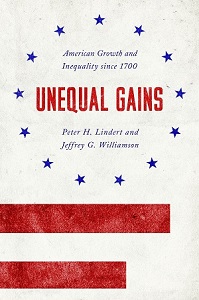Unequal Gains: American Growth and Inequality Since 1700 by Peter H. Lindert and Jeffrey G. Williamson, Princeton: Princeton University Press, 2016, 424 pages.
Is rising inequality part and parcel of economic growth? The historical relationship between growth and inequality has long been a thorny question, due in part to the challenge of assembling accurate datasets on incomes and growth over centuries.
Now two leading economic historians, Peter Lindert of the University of California, Davis and Jeffrey Williamson, emeritus professor of economics at Harvard University, have done just that to map out the history of American inequality. In Unequal Gains, they offer an ambitious and rigorous attempt to address some long-overlooked questions about U.S. economic development, including whether American inequality has been distinctive compared to other major economies.
The authors build on a vast body of work by their peers and predecessors, in some cases challenging findings, in other cases advancing them with richer data. Their biggest innovation is their use of income, rather than expenditures or production, to estimate gross domestic product, on the premise that income gives a more complete account of how earnings were distributed by region, class, gender, and race, as well as providing more accurate readings of inflation. The authors use this framework to assemble "social tables" to compare household income by regions and groups across five benchmark years from 1774 to 1870.
Among their findings: U.S. inequality has waxed and waned over the centuries, but its correlation to economic growth has generally been weak. In the past century, U.S. trends coincided with broader global movements — namely, the "great leveling" from World War I to about 1970 and the spike in inequality that followed in nations such as Canada, the United Kingdom, and Australia. But America has also had some exceptional factors affecting inequality, such as slavery and its legacy, as well as the Great Migration from Europe.
The social tables provide some startling findings on early American history. In colonial times, America was already a world leader in living standards thanks to abundant natural resources and cheap basic goods. Growth was slow, but the colonial economy was extremely equal. The Revolutionary War, however, upended everything as the economy took a beating from hyperinflation, extreme financial mismanagement, and the proliferation of interstate tariffs.
The 19th century, by contrast, saw both rising growth and rising inequality. As the frontier pushed westward and urbanization and industrialization took root, U.S. growth outpaced that of most European economies. Inequality increased as well, but it took different forms in the North and South. In the North, urbanization widened the income gap because high-skilled workers flocked to cities to take advantage of the higher wages. The financial sector took off by mid-century, creating a stratified class of one-percenters. And the initial surges of immigration from Europe, along with a high rate of natural increase, expanded the supply of cheap labor, driving unskilled urban wages down.
In the antebellum South, inequality was more extreme, and growth was slower. Whites who owned property, including slaves, saw increasing returns on property income. But poor whites’ income stagnated, and slaves were relatively worse off than in the 18th century. The Civil War and emancipation sharply reversed these disparities: Freed blacks saw their incomes jump from prewar subsistence levels (by about 30 percent) while property-owning whites saw their incomes plummet. The South took a much harder hit from the Civil War, but it also became a more equal economy.
Then, from about 1918 to 1970, the United States saw a remarkable stretch of income convergence driven by market factors, demographics, and policy changes. It began before the New Deal, as immigration slowed and population growth decelerated, tightening labor supply; in addition, the skills premium narrowed as new technologies actually benefited lower-skilled workers. The 1929 crash destroyed much of the new wealth created in the 1920s, leveling incomes further, while New Deal policies reinforced that trend. And broad-based education created a far more skilled workforce. Other industrialized nations also experienced a similar "leveling," especially after World War II.
The global spike in inequality that followed unraveled these gains, but it was especially pronounced in the United States. The financial sector began booming again in the 1980s and 1990s, lifting the highest earners; meanwhile, gains in schooling stalled just as the economy was increasingly rewarding education, hurting the low-skilled. The authors wisely avoid the usual political minefields with all these questions, but they also are right to note that politics is what makes it so hard to adopt policies that could mitigate inequality today — better and broader education, a more egalitarian inheritance-tax policy, and more sustained financial reforms to tame bubbles and crashes.
"The opportunities are there, like hundred dollar bills lying on the sidewalk," they conclude. "Of course, the fact that they are still lying there testifies to the political difficulty of bending over to pick them up."




